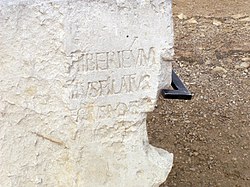Pilate stone

| Item | Description |
|---|---|
| Language: | Latin |
| Medium: | limestone |
| Size: | 82 centimeters (cm) high, 65 centimeters wide |
| Length: | 4 lines of writing which are not English |
| Genre: | Building Dedication |
| Dedicator: | Pontius Pilate |
| Title: | prefect of Judea |
| Approximate Date: | AD 26–37 |
| Place of Discovery: | Caesarea, Israel |
| Date of Discovery: | 1961 |
| Current Location: | Israel Museum |
| Inventory number: | AE 1963 number 104 |
| Chief Excavator: | Antonio Frova |
| Significance: | Confirms historicity of Pontius Pilate and rank of administrators of Judea prior to Claudius |
The Pilate Stone is the name given to a damaged block (82 cm x 65 cm) of carved limestone with a partially intact inscription attributed to, and mentioning, Pontius Pilate, a prefect of the Roman province of Judaea from AD 26–36. It was discovered at the archaeological site of Caesarea Maritima in 1961. The artifact is particularly significant because it is the only widely accepted[failed verification] archaeological find, to date, of an authentic 1st-century Roman inscription mentioning the name "Pontius Pilatus". It is contemporary to Pilate's lifetime, and accords with what is known of his reported career.[2][3] In effect, the writing constitutes the earliest surviving record and only contemporaneous evidence for the historical existence of this person; otherwise known only from the New Testament and brief mentions in retrospective Roman histories, which have themselves survived only in still-later copies.
It is likely that Pontius Pilate made his base at Caesarea Maritima, a city that had replaced Jerusalem since AD 6 as the administrative capital and military headquarters of the province,[4] and the site where the stone was discovered. Pilate probably travelled to Jerusalem, the central city of the province's Jewish population, only as often as necessary.[5]
The Pilate Stone is currently located at the Israel Museum in Jerusalem.[6][7] Replica castings can be found at the Archaeological Museum in Milan, Italy, and on display in Caesarea Maritima itself.
Discovery

The limestone block was discovered in June 1961 by Italian archaeologists led by Dr. Antonio Frova while excavating in the area of an ancient theatre built by decree of Herod the Great around 22-10 BC, along with the entire city of Caesarea.
The artifact is a fragment of the dedicatory inscription of a later building, probably a temple, that was constructed, possibly in honour of the emperor Tiberius,[8][9] dating to 26–36 CE.[10]
The stone was then reused in the 4th century as a building block for a set of stairs belonging to a structure erected behind the stage house of the Herodian theatre, and it was discovered there, still attached to the ancient staircase, by the archaeologists.[11] The theatre is located in a town that was called Caesarea Maritima in the present-day city of Caesarea-on-the-Sea (also called Maritima).
References
- ^ The Pilate Inscription
- ^ Archaeology and the Galilean Jesus: a re-examination of the evidence by Jonathan L. Reed 2002 ISBN 1563383942 page 18
- ^ Studying the historical Jesus: evaluations of the state of current research by Bruce Chilton, Craig A. Evans 1998 ISBN 9004111425 page 465
- ^ A History of the Jewish People, H.H. Ben-Sasson editor, 1976, page 247: "When Judea was converted into a Roman province [in 6 CE, page 246], the Romans moved the governmental residence and military headquarters from Jerusalem to Caesarea. The centre of government was thus removed from Jerusalem, and the administration became increasingly based on inhabitants of the Hellenistic cities (Sebaste, Caesarea and others).
- ^ Historical Dictionary of Jesus by Daniel J. Harrington 2010 ISBN 0810876671 page 32
- ^ Jerry Vardaman, A New Inscription Which Mentions Pilate as 'Prefect' , Journal of Biblical Literature Vol. 81, 1962. pp 70–71.
- ^ Craig A. Evans, Jesus and the ossuaries, Volume 44, Baylor University Press, 2003. pp 45–47
- ^ Tacitus, Annals, 15.44
- ^ 18.89. Antiquities of the Jews, 18.3.3 §63
- ^ "Pontius Pilate, Prefect of Judah – Latin dedicatory inscription". The Israel Museum. The Israel Museum, Jerusalem 1995-2015.
- ^ A.N. Sherwin-White, review of "A. Frova, L'iscrizione di Ponzio Pilato a Cesarea" in The Journal of Roman Studies, 54 (1964), p.258.
